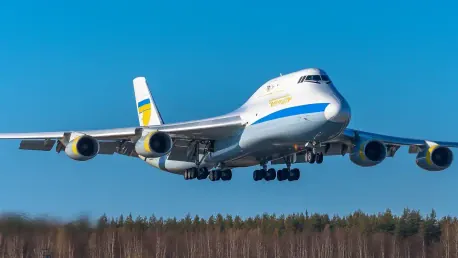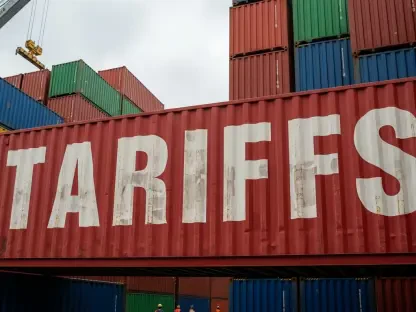The article examines how Ukraine’s air cargo industry is navigating the ongoing conflict with Russia. It emphasizes the industry’s resilience, the strategic adjustments made by key players, notably Antonov Airlines, and the international support aimed at sustaining and eventually rebuilding this critical sector.
The Vital Role of Ukraine in Global Cargo Aviation
Historical Significance
Ukraine’s air cargo industry has a deep legacy dating back to the Soviet era. Home to Antonov, a world-renowned aircraft manufacturer, Ukraine developed iconic cargo planes like the An-124 “Ruslan” and An-225 “Mriya.” These aircraft were not merely engineering marvels but also pivotal in shaping the global logistics landscape. The An-124, for instance, could carry heavy cargoes that other planes couldn’t handle, making it indispensable for military logistics, humanitarian missions, and complex industrial transports. The An-225, the world’s heaviest aircraft, further reaffirmed Ukraine’s leading expertise in manufacturing large cargo aircraft, offering unmatched capacity.
The enduring legacy of these aircraft has been instrumental in Ukraine’s role in global aviation logistics. Antonov’s ability to create such robust machines set a high standard in the cargo aviation sector, combining technological innovation with operational capability. Through decades, the success of these aircraft has established a strong reputation, with Antonov planes becoming iconic symbols of strength and reliability in the cargo aviation realm. Despite the political upheavals and economic challenges following the Soviet Union’s dissolution, Ukraine managed to retain and commercialize a portion of this remarkable fleet, continuing to contribute significantly to global logistics.
Contribution to Global Logistics
These mighty aircraft became essential assets in global logistics, capable of transporting outsized and heavy cargo across the world. They played significant roles in international relief efforts, military support, and fulfilling commercial needs. The An-124 and An-225 have been critical in handling tasks that are nearly impossible for other aircraft, including transporting massive wind turbine blades, large construction vehicles, and even entire locomotives. Their unique capabilities have made them the go-to solution for moving immense loads that require special handling and transportation methods.
In the commercial sector, the ability of Antonov aircraft to transport oversized commodities has been crucial for industries ranging from aerospace to oil and gas. They have facilitated the delivery of components too large for standard cargo planes, ensuring that projects proceed without the delays or additional costs associated with disassembling large items. In humanitarian scenarios, Antonov carriers have delivered vital supplies to areas affected by natural disasters or conflict zones, proving essential in rapid response and aid distribution. With such pivotal contributions, these aircraft have been a linchpin in the broader framework of global logistics, enhancing efficiency and reliability in a myriad of logistical operations worldwide.
Dire Impact of the Russian Invasion
Infrastructure Destruction
The Russian invasion in February 2022 resulted in the severe damage of key aviation infrastructure. The attack on Antonov-2 Hostomel Airport near Kyiv was particularly devastating. As Antonov’s home base, Hostomel was more than just an airport; it was the heart of Ukraine’s aviation engineering and operations. The site housed invaluable resources, including workshops, hangars, and Antonov’s unique fleet. The destruction inflicted on the airport facilities and surrounding infrastructure was catastrophic, disrupting operations and causing a substantial financial and operational setback for Antonov Airlines.
Alongside the damage to infrastructure, several of Antonov’s unique aircraft, such as the An-22, An-225, and An-124, were significantly damaged or completely destroyed. This not only represented a massive asset loss but also an emotional blow to Ukraine’s aviation heritage. The damage extended to Antonov’s head office and technical facilities, crippling their ability to maintain and deploy aircraft effectively. In combination, these losses translated into a significant interruption of Ukraine’s contributions to global cargo logistics and a serious threat to the nation’s broader economic and strategic interests in the aviation sector.
Catastrophic Halt in Operations
Due to safety concerns, major airports and airspace in Ukraine were closed, causing a complete halt in commercial aviation. This disruption forced airfreight operations to reroute through neighboring countries, complicating logistical efforts. Major hubs such as Boryspil International Airport, which had seen record cargo volumes in recent years, were left eerily silent. The sudden cessation of operations posed not just logistical challenges but also significant economic implications for businesses dependent on timely cargo delivery.
As airspace closures mandated diversions, Poland’s Rzeszów-Jasionka Airport emerged as a crucial logistics gateway. Handling around 90% of military and humanitarian aid destined for Ukraine by air, it became an alternative hub that kept the supply chains alive. This adaptation was critical for maintaining essential links, but it came with increased complexity, longer transit times, and higher costs. The rerouting efforts, while necessary, underscored the fragility and interconnectedness of global logistics networks and the profound impact of geopolitical events on commercial aviation operations.
Resilience in the Face of Adversity
Strategic Relocation
Antonov Airlines displayed remarkable adaptability by relocating its operations to Leipzig Halle Airport in Germany. Germany’s logistical and maintenance support enabled Antonov to maintain its global operations. The move demonstrated not only the airline’s resilience but also its capability to swiftly recalibrate its strategy amidst crisis conditions. Leipzig Halle Airport, with its strategic location and extensive facilities, offered a sanctuary where Antonov could continue functioning while ensuring safety and stability for its operations and personnel.
This strategic relocation was not just a temporary fix but a calculated maneuver to leverage existing international cooperation and support. By basing their operations in Germany, Antonov could access critical maintenance facilities, technical support, and logistical networks essential for their continued operations. This shift underscored how adaptable and robust Antonov’s logistical framework was, allowing them to maintain service continuity despite the significant disruptions back home.
Continued Operations Amidst Conflict
Despite the challenges, Antonov’s fleet of five An-124s continued to serve global clients, particularly in critical industries, filling a gap left by grounded Russian competitors. This resilience underscored Antonov’s vital role in the global logistics network. As Russia’s Volga-Dnepr, a major competitor, faced sanctions and operational restrictions in Europe, Antonov’s capacity to continue operations became even more crucial. Their ability to transport oversized cargo was unmatched, ensuring significant projects worldwide could proceed without further disruptions.
Key sectors like aerospace, oil and gas, and heavy engineering relied heavily on Antonov’s services during this tumultuous period. The continued operations of Antonov not only met immediate logistical needs but also maintained a critical supply chain link that many global enterprises depended on. This situation highlighted the strategic importance of Antonov’s fleet and the expertise of its crew, who expertly managed complex logistical demands even under extraordinary circumstances.
International Support and Strategic Alliances
Collaborative Efforts
International cooperation emerged as a key lifeline for Ukraine’s aviation sector. European and North American hubs provided crucial support, ensuring Ukrainian operations remained active and connected. Organizations such as NATO contracted Antonov Airlines for essential defense transport, recognizing the unparalleled capability of their aircraft in moving oversized and critical military equipment. This partnership not only provided operational continuity but also fortified international security alliances.
Additionally, support from airports in Turkey, the UAE, and Canada emphasized a global effort to maintain Ukraine-connected logistics channels. These collaborations enabled Antonov to keep fulfilling global logistical needs while simultaneously supporting Ukraine’s broader economic engagements. The international community’s active participation highlighted a concerted effort to ensure that Ukraine’s logistical contributions remained viable even during the conflict.
Prospective Investments
Reconstruction plans have sparked discussions about significant international investments. Collaborative efforts are aimed at transforming damaged facilities into modern cargo hubs, demonstrating long-term commitment to Ukraine’s aviation future. Early initiatives to rebuild Antonov’s base at Hostomel Airport envision it becoming a state-of-the-art logistics center, potentially surpassing its former capabilities.
Ground-level discussions with international stakeholders suggest promising prospects for joint ventures and funding opportunities. These engagements are not merely focused on restoring pre-existing capabilities but on leveraging this rebuilding phase to integrate advanced technologies. Prospective investments aim to create resilient logistics infrastructure, setting a new standard for the region. This international collaboration underscores the potential for a rejuvenated Ukrainian aviation sector that could set benchmarks for efficiency and innovation.
Prospects for Rebuilding and Future Growth
Planning Amidst Conflict
Despite the ongoing conflict, planning for the future remains active. Restoring infrastructure, reopening airspace, and modernizing regulations are seen as critical steps for revival. Strategic blueprints are being laid out to rehabilitate the damaged architectural landscape of Ukraine’s aviation infrastructure. Simultaneously, policies are being examined and reformed to match modern aviation standards and practices.
These plans involve not only physical reconstruction but also a vital overhaul of logistical frameworks to ensure resilience against future disruptions. Integrating crisis management strategies into operational plans is another focus, fostering a preparedness framework that could circumvent the setbacks experienced during the current conflict. Ukraine’s aviation stakeholders are working tirelessly to introduce innovations that would make the air cargo sector more robust and adaptable in the face of adversity.
Vision for Modernization
Rebuilding efforts for Antonov’s home base and constructing a new An-225 Mriya symbolize Ukraine’s ambitious future in aviation. These projects, involving international partnerships, aim to restore and enhance the sector’s capabilities. The vision includes not just restoring but significantly upgrading logistics capacities, incorporating cutting-edge technologies to optimize efficiency.
Plans to rebuild the An-225 Mriya with modern enhancements reflect broader aspirations for the industry’s growth and recovery. The project’s symbolism is profound, representing a determined push to reclaim and advance Ukraine’s position in global aviation. These ambitions also involve nurturing international collaborations to ensure sustainable growth, technological advancements, and strategic innovations within Ukraine’s air cargo industry.
The Symbolism of the An-225 Mriya
An Icon of Resilience
The An-225 Mriya, a symbol of Ukraine’s aerospace ambitions, was significantly impacted by the conflict. Its planned reconstruction embodies the nation’s spirit and determination to regain its standing in the aviation world. The loss of the Mriya was not just material but emotional and symbolic, representing a challenge to Ukraine’s innovative legacy. However, the determination to rebuild it signifies a profound resistance and a commitment to rise from the ruins with renewed vigor.
This project to resurrect the Mriya gathers significant international interest and support, transforming it into a global endeavor that showcases united efforts towards innovation and recovery. By reintroducing a revamped Mriya, Ukraine aims to highlight its continuous drive for excellence and advancement in the aerospace sector. The reconstruction of this iconic aircraft stands as a powerful testament to overcoming adversity through collective resolve and innovative engineering.
Future Aspirations
Ukrainian authorities’ commitment to rebuilding the Mriya with modern enhancements reflects broader aspirations for the industry’s growth and recovery. This project serves as a testament to the resilient and forward-looking mindset of Ukraine’s aviation sector. With modern technological integrations, the new Mriya aims to surpass previous benchmarks, setting a new paradigm in cargo transportation.
The ambition extends beyond merely restoring a lost marvel but aims to enact a revitalized aviation era. It envisions an enhanced production line, advanced engineering practices, and a collaborative international synergy that foregrounds Ukraine’s role in global aviation innovation. These aspirations encapsulate a broader narrative of resilience, reflecting the unyielding spirit of the nation and its unwavering commitment to advancing despite the odds.
Conclusion
The article explores the resilience of Ukraine’s air cargo industry amid the ongoing conflict with Russia. It highlights the strategic moves made by industry leaders, especially Antonov Airlines, to adapt to the challenging circumstances. Despite the tumultuous environment, these key players have shown remarkable fortitude in maintaining operations.
To navigate these tough times, the industry has not only relied on internal strengths but also on international support. This external assistance is pivotal for sustaining current operations and is geared towards the eventual reconstruction of this crucial sector. The international community recognizes the importance of Ukraine’s air cargo industry and has stepped in with aid, providing both financial support and logistical expertise.
Antonov Airlines, renowned for its fleet of giant cargo aircraft, has been at the forefront of these efforts. The airline has made tactical adjustments to ensure continuity in services, showcasing innovative strategies to overcome the significant logistical challenges posed by the conflict.
This determination and adaptability reflect the broader resilience of Ukraine’s air cargo sector. The industry’s ability to pivot and adjust not only underscores its critical role in global logistics but also its potential for recovery and growth in the post-conflict future.








